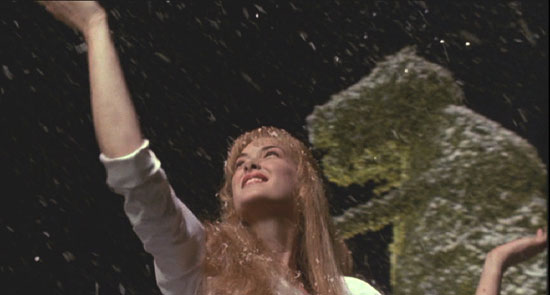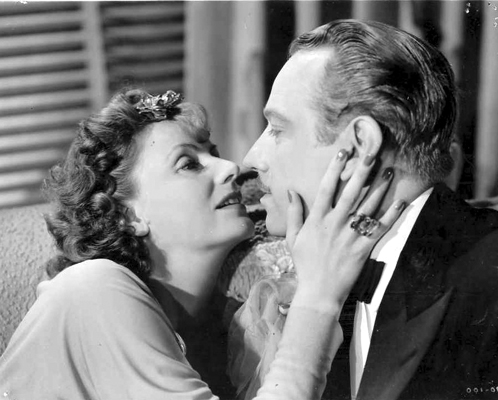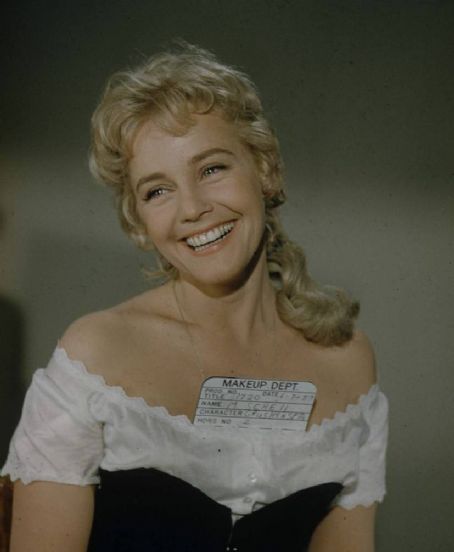Also, Netflix released on Instant Watch Season 7 of How I Met Your Mother, and needless to say I had to watch it. In my challenge to watch on average 1 movie a night, television shows fall into the "fine print" category. There has already been a journal entry about The Walking Dead, and I counted that as one "movie." (Maybe one day I'll delve into the ever-blurring line between TV and Movies.) So, I will do the same for HIMYM, but because I love the show so much (I will go out on a limb and say that it is probably my favorite TV show of all time) and because I watch it so often, not just on a single day, I will reserve the HIMYM journal entry for its own special post.
In this round of journal entries, I went through a whirlwind of emotions that drove my choices in films. Some older (Ninotchka, Notorious), some from the same director (Woody Allen), some "holiday" (Eight Crazy Nights), and all worth checking out, and hopefully my words will inspire you, intrigue you, or whatever you to just go out of your comfort zone and check out one of these films.
****WARNING SPOILER ALERT****
22.) How I Met Your Mother
(2005-2012) Season 7, 12/2/12 – 12/18/12
Exclusive journal entry coming soon!
23.) Hannah and Her Sisters
(1986) 12/3/12
I went on a Woody Allen
kick this week. I reserved a few of his films I haven’t seen and have wanted to
see, and I went about it chronologically, this being the first of three.
As per usual for an
Woody Allen film, there are nearly, nearly,
too many stars to name, but I'll name 'em: Michael Caine, Barbara Hershey,
Carrie Fisher (Princess Leia, duh. But also in a bunch of other ‘80’s gems ala When Harry Met Sally), Mia Farrow (in
the wake of my Rosemary’s Baby
outing), Diane Wiest (She was in Edward Scissorhands and Footloose!),
don’t forget Max Von Sydow (he’s been in everything, most recently Extremely Loud and Incredibly Close),
and naturally Woody Allen in a role that I actually liked him in.
 |
| (Left to Right) Diane Wiest, Barbara Hershey, Maureen O'Sullivan (the mother), Mia Farrow, Michael Caine |
Amongst Allen’s very poignant Thanksgiving dinners (there
are three in this film), aunts, uncles, the family is crowded around the piano
listening to Dad serenade Mom while uncle So-and-so gives the little kids what
are surely their first beers. The scene plays out like a home-movie, everybody
reminisces, “Hey, remember that one Thanksgiving when Uncle So-and-so gave all
the kids beer?” There are family scenes in all of Allen’s films, but for me,
this one is the most ardent scenes of his. It plays well into the rest of the
theme of his film: it’s funny how things—people’s lives—can turn out years
later.
The film is about a love web, not a triangle, and how
pleasantly amusing and pleasing the results can be. Mickey (Allen) and Hannah
(Farrow) are divorced. Hannah’s new husband (Caine) has a crush on, then an
affair with Hannah’s sister Lee (Hershey). Lee dumps him and falls for another
guy. Step back a while, after Hannah and Mickey's divorce, Hannah tried setting Mickey up with
her other sister Holly (Wiest) with disastrously incompatible results. Then
after Mickey has a mid-life crisis of sorts years later, he and Holly end up, by
chance, stumbling upon each other in a record store. They court and end up
falling in love with each other. Timing. That is what love is all about. That is
Woody Allen’s message here. And timing is a funny thing.
24.) Crimes and Misdemeanors
(1989) 12/312
Starring Martin Landau
(he was in Ed Wood, a few episodes of
Entourage, and a long time ago North by Northwest. You’d barely
recognize him without his glasses and with dark-colored locks.) Also starring
Angelica Huston, Sam Waterston (form Law
and Order and the little gem Capricorn
One), Woody Allen and again Mia Farrow! Oh, and directed by the Woodster.
It’s an “ethical dilemma because I’m married,” Cliff
(Allen) says to his niece about his infatuation with Halley (Farrow). The
difference between crimes and misdemeanors is essentially a moral dilemma. The
film Crimes and Misdemeanors is split
into several dualities. First, there are two moral dilemmas. The dilemma Cliff
is having about whether he should cheat on his wife because the marriage is
basically over, and the dilemma that Judah (Landau) is having, whether or not
to kill his mistress and whether or not to give himself up.
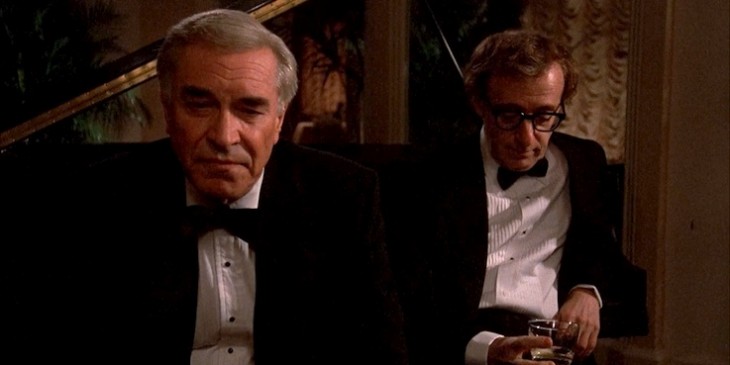 |
| I mean really, what better image do you need? (Martin Landau, Woody Allen) |
Another duality is that each man, Cliff and Judah confess
to someone who in their lives would normally “confess” things to them. Cliff
tells his niece all his relationship problems and seeks her guidance, and
humorously so, she gives it. A doctor, Judah entrusts his secrets to his
patient Ben (Waterston)—who is also a friend—while in the examination room.
Judah is playing doctor, but instead of curing Ben’s slowly progressing
blindness (justice is blind?), the roles are reversed again and Ben is the one
giving out the consolation.
These dualities become clear in the final scene of the
film, when Cliff and Judah meet at a party and share a drink together. Judah
explains the dilemma between crimes and misdemeanors. The fine line between
them is in choice, choosing to be the bigger man and turning yourself in if
you’ve committed a crime, but being an even bigger person and never making the
misdemeanor choices that lead to their dilemma—their guilt. As Judah points
out, referring to what seems like scripture, “And after the awful deed is done,
he finds that he's plagued by deep-rooted guilt.”
25.) Manhattan Murder Mystery
(1993) 12/4/12
This is Woody Allen
playing Alfred Hitchcock.
Starring mainstays
Angelica Huston, Alan Alda, and Diane Keaton.
I feel like this is Allen’s humorous homage to Alfred
Hitchcock. The entire story seems as if Hitch wrote it himself. The main
characters all sit around a table discussing murder. This was something
Hitchcock loved to do, have his characters parlor-talk about murder, then there
talk turns to hysteria, and “imagining” someone close to them murders someone
else.
 |
| Mirror Scene with Woody Allen. |
Carol (Keaton) starts it off, imagining that Larry
(Allen) and her neighbor killed his wife to disguise several affairs he was
having. In the process, Larry slowly becomes more convinced of the murder
taking place, he becomes more jittery (just as Allen always is), but ultimately
he become more brave, ultimately saving his marriage and riding in at the end
of the film as Carol’s White Knight, which is escalated in the hilarious scene
where Larry offers his neighbor his wife’s corpse, (that he doesn’t have). So
he dresses up a dummy in women’s clothes and hides it in the trunk of his car
and to make on last, feeble attempt to throw off his neighbor. The film ends in
one last amusing homage to The Lady from
Shanghai, when the neighbor confronts his mistress behind a theater screen,
in a room full of mirrors as the same scene in Lady from Shanghai plays in the theater.
26.) Notorious (1946) 12/4/12
Speaking of Hitchcock,
we’ll just follow up Woody with Alfred.
Starring Cary Grant,
Ingrid Bergman (Casablanca but also Belle’s of St. Marys one of my favorite
Christmas movies), and Claude Raines (also most notably from Casablanca) Directed by Alfred
Hitchcock.
I will be brief with this one. I could go on about the
countless brilliant aspects of this film, like the stairway throughout the
film, or how Hitch build suspense like none other in the wine cellar scene, or
about how gorgeous Bergman is and accredit them to Hitch’s genius (which would
be justified), but I will forgo the usual compliments, to say that man, does he
know how to use the Dutch-tilt. For those who don’t know what a Dutch-tilt is,
see the following photo:
 |
| Cary Grant photographed from an upside-down Dutch-tilt angle. |
The Dutch-tilt or Dutch
angle is typically used to show that there is something askew about the image
or the scene in the film. Hitchcock does it the best, especially to add more
suspense ti his films. And I applaud him for using it with such grace (unlike
Kenneth Branagh in Thor as I describe
in an earlier post.)
Another underrated mastery of Hitchcock’s is how he
block’s his kissing. At the time of Notorious’s
release, the Production Code had rules about kissing—and just about everything
else for that matter. But, it stated that a kiss couldn’t last longer than
three seconds. So, Hitchcock got past that by the heated make-out session
between Grant and Bergman that is sprinkled with rubbing of noses and heavy
breathing—which sounds more sensual to you? And who is the smart one now?
27.) Eight Crazy Nights
(2002) 12/6/12
In celebration of St.
Nick’s day, I watched this, one of the most raunchy, disgusting (Holiday) films
ever, but for some reason I still love it. This animated new “classic” stars
all of the Happy Madison (the Adam Sandler production company) regulars.
Sandler of course, Rob Schnieder, Kevin Nealon, etcetera, etcetera, and lined
with raunchy and sometimes (rarely) touching songs by Sandler.
My youthful affinity for Sandler and his earlier films
(especially Waterboy) is probably the
reason that I’m not completely turned off by the filth that is this film.
Everyone’s allowed a couple guilty pleasures, and for me, Holiday films, in
particular Christmas films, no matter how bad they are, hone into my sense of
nostalgia. This is one that I remember freezing my tush off watching it on the
big screen in my barn with my brother and some of my closest friends. It was hilarious and appealed to our
high-school minds, and looking at it again, I realize that it is part of a
genre of animated films: animated musicals. This is a practice that has gone
out of style, say so-long to all the claymation classics. With the likes of
Pixar greats like Toy Story for example,
animated films have good soundtracks (regardless of how you feel about Gary
Newton) with original songs, but it doesn’t feature the characters singing these
songs. The same thing can be said for Up
and many of the other Pixar films. Eight
Crazy Nights is a throw-back (for Sandler) to his raunchy stand-up days,
mixed with some self-deprecating songs that just plain offend you and everybody
else you know.
28.) Ninotchka (1939) 12/7/12
Starring the great
Greta Garbo and her muse Melvyn Douglas in the second of their three pairings,
(Two-faced Woman which I watched
earlier and As You Desire (1932) which
has now been added to my “watch” list).
Directed by Ernst
Lubitsch, who was Garbo’s favorite director to work with, and written by a young
Billy Wilder (who directed one of my personal favorites Some Like It Hot (1957), also Sunset
Boulevard (1950) and Double Indemnity
(1944) which are I write about later in my journal). Also, George Cukor was
scheduled to direct this but left to do a little old film called Gone with the Wind (1939).
Now that I’ve made all my pretentious
six-degrees-of-Kevin-Bacon connections (which I swear will all have relevance later),
I will feign over Greta Garbo for a while, but only after I comment on the
writing! It seems I tend to do this a lot with these older films, but this is something
that should be understood that older films were some much better written. Then
had less of a visual crunch (ie Special Effects) to lean on. In Ninotchka, the titular Garbo is a stern
Russian “comrade” sent to Paris then becomes falls for the slick Melvyn Douglas
character. Garbo’s attitude exudes in sequences like when Melvyn Douglas is
attempting to seduce Ninotchka (Garbo) for the first time. She says to him, “You’re
so talkative.”
 |
| Garbo overpowering Douglas with her charm. |
They kiss, and then Douglas replies, “Was that Talkative?”
“No that was restful.” She says deadpan. “Again.”
They kiss.
“Thank you,” she says.
“Oh my barbaric Ninotchka. My impossible unromantic statistic.”
They kiss.
“Again,” she says.
Exchanges like that are just wonderful and show how much
control both the character Garbo was playing and Garbo herself was in control. She
typically played very powerful, strong and feminist characters. If you look at
the rest of Ninotchka, she over-sees
three other bumbling, womanizing Communist Russians, (who actually quip a line I
find hilarious: “Capitalist methods: they accumulate millions by taking the
loss.”) But back to Garbo. In relation to the whimpering Douglas, she is in
control the entire time. In the exchange I mention, although she is the one
being kissed, it is on her terms. She is telling Douglas what to do. She
commands, “Kiss me.” And, “Again.” It’d be hard finding another woman on screen
who demanded that much attention with just three words.
29.) The Last Detail (1973) 12/7/12
Starring Jack Nicolson,
Randy Quaid (cousin Eddy, anyone?), and Otis Young.
Directed by Hal Ashby,
who directed Harold and Maude (1971)
that I watched earlier, and written by Robert Towne who wrote Chinatown (1974) which was directed by
Roman Polanski who also directed Rosemary’s
Baby (remember?). Although uncredited, he wrote Bonnie and Clyde until it was taken out of his hands.
From what I’ve seen and especially what I’ve read, Hal
Ashby is a directed who flourished and suffered during the American New Wave/New
Hollywood movement during the late Sixties and Seventies. Unlike Spielberg or
Francis Coppala, Ashby’s legacy especially in mainstream American cinema has been overlooked. Most credit this to
his lack of visual style, which may be a fairly valid point; however, his films
do have a style. His style is dealing with different issues.
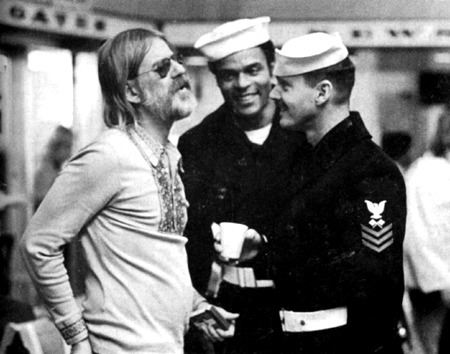 |
| Hal Ashby, Otis Young, Jack Nicholson on the set of The Last Detail. |
Harold and Maude and The Last Detail are both politically
charged films. The Last Detail deals
directly with the military, in this case the Navy, and two sailors (Nicholson
and Young) who are ordered to take a third (Quaid) to prison, but throughout
the entire film, the three do just about everything but follow military orders.
They drink, fight, and get hookers, and then in the end nearly go AWOL. They
start to question the establishment much as Harold does throughout Harold and Maude. He constantly does the
opposite of what his mother expects.
The Last Detail is also a coming of age
story, like Harold and Maude. Randy
Quaid’s character does everything. He loses his virginity, he gets really hammered
with the guys, he almost sees his mother one last time, and says that he doesn’t
want to do any of that again because he doesn’t want to ruin the significance
of it. This is almost like Ashby’s career. He dabbles in a little bit of
everything, the generation gap, the military, the counter-culture movement in Coming Home (1978), and a sociological
experiment in Being There (1979) just
to name a few. They all deal with something a little bit different. So, maybe
Hal Ashby’s style was just a little bit different.


